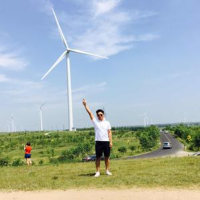DMAA事务所赢得了上海前世博会场地上的一项温室设计竞赛,该竞赛也是上海世博文化公园项目的一部分。当局希望将这片位于园区中心的储备土地改造为高质量的休闲区,也代表了全球核心地区密集绿化的发展趋势。
As part of the project for the Expo Cultural Park in Shanghai, DMAA won a competition for the realisation of a series of greenhouses that are being built on the city’s former Expo site. The decision of the city authorities to transform such a large, centrally- located reserve of land into a high- quality recreational zone offers clear proof of the global trend towards the more intensive greening of core urban areas.
▼项目概览,Overall view© DMAA

▼建筑全貌,Overall view of the building© DMAA


本次竞赛的条件之一是需要保留场地中一栋前工厂建筑,DMAA的方案是将该建筑群改造为综合体,用于配送功能,其中种植了需要不同植被和气候条件的温室、游客中心以及多个餐厅和休闲空间,总面积为41000平方米。设计者以中国文化“阴阳”中的双重能量为灵感,在现有的模块化、线性简单结构的工厂大厅,与独立有机的15至22米的温室雕塑之间建立的联系,温室方案被融入进现有的结构中,设计者还在屋顶处打造了一系列哒的圆形开窗。
One of the conditions of the competition was the retention of a former factory building that is used, in DMAA’s proposal, as a distribution zone for the complex, which contains greenhouses with a range of different vegetations and climates, a visitors’ centre and numerous restaurants and other spaces for relaxation with a total usable area of 41,000m2. The principle of dual energies that is set out in the Chinese philosophy of “Yin and Yang” was the starting point for the architectural approach. This establishes a dialogue between the modular and linear structure of the existing factory hall and the sculptural articulation of the individual, organic, 15-to-22-metre high greenhouses, which are woven into this existing structure, and whose roofs are perforated with a series of large circular openings.
▼室内空间,Interior view© DMAA



本项目旨在打造零能耗建筑的严格要求,方案与周围的景观公园之间的融合也完美体现了这一点。温室周围宽广的水面不仅能够在炎热的夏季起到降温作用,光伏电站也被设置在这片水面之下几厘米处,和工厂建筑屋顶上的附加面板共同为不同区域所需的气候进行功能。这种功能的理念是设计者与Transsolar Energietechnik董事总经理Thomas Auer共同开发的,以单层玻璃的结构为基础,最大限度地增加日光照射效率,温室上多个大型开窗也确保了问室内的植物能够获得足够的光照。
The design, which was conceived to meet the exacting ecological requirements of a zero-energy building, is also reflected in the gentle and harmonic insertion of the complex into the surrounding landscape park. The large area of water surrounding the greenhouses not only provides cooling in the hot summer months, but is also home to a photovoltaic plant that is located just a few centimetres below the surface of the water and, together with additional panels on the roof of the existing factory building, supplies the energy required to control the various climatic areas. The energy concept, which was developed together with Thomas Auer, Managing Director of Transsolar Energietechnik, is based on the decision to glaze the greenhouses with a single layer of glass in order to minimise the filtering of the daylight. The generous openings in the roofs of the pavilions also ensure that the plants receive enough daylight.
▼室内引入自然光线,Bringing natural light into the interior© DMAA

▼夜览,Night view© DMAA

室内精心的空间设计,能够引领游客从沙漠的峡谷和沙丘风光,一路感受到热带雨林的沼泽瀑布、名为云端花园的梯田景观,再到鲜花盛开的花塔。空间尽头,游客还可以参观工厂建筑的屋顶露台,从这里能够俯瞰整个公园的景色,还有周边的城市之景。
The spatially orchestrated vegetation scenarios lead visitors from the ravines and sand dunes of the desert pavilion, via the swamps and waterfalls of the tropical rainforest and the terraced landscapes of the so-called cloud garden, to the opulent blossoming of the towers of flowers. The tour is completed by the opportunity to visit the terrace on the roof of the existing factory building, from where visitors can take in the entire park and, beyond this, the built edge of the surrounding city.
▼总平面图,site plan© DMAA

▼一层平面图,1F plan© DMAA

▼二层平面图,2F plan© DMAA

